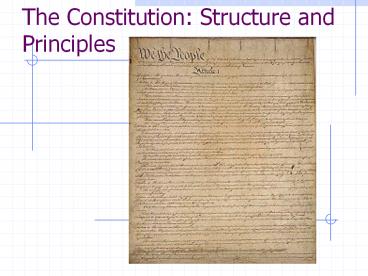The%20Constitution:%20Structure%20and%20Principles - PowerPoint PPT Presentation
Title:
The%20Constitution:%20Structure%20and%20Principles
Description:
The Constitution: Structure and Principles The U.S. Constitution The Founders created the Constitution with the desire to set up a republic, power held in elected ... – PowerPoint PPT presentation
Number of Views:182
Avg rating:3.0/5.0
Title: The%20Constitution:%20Structure%20and%20Principles
1
The Constitution Structure and Principles
2
The U.S. Constitution
- The Founders created the Constitution with the
desire to set up a republic, power held in
elected representatives. It set up a separation
of powers to ensure this. Our governments
success depends on its citizens being informed.
An understanding of the constitution is key to
understanding American government.
3
The U.S. Constitution
- Compared with other Constitutions, the U.S.
Constitution is simple and brief. - The Constitution is a blueprint, or guide, for
government but does not spell out every aspect of
how government will function. - The Constitution contains 7,000 words and is
divided into three parts the Preamble, the
articles, and the amendments.
4
Structure of the Constitution
- or, how the document is set up.
5
The Preamble
- The introduction, which states why it was
written. - The founders wanted a government which would
- 1. provide stability and order,
- 2. Protect citizens liberties,
- 3. Serve the people.
6
Seven Articles
- There are seven divisions, or articles, which
cover a general topic. - Article I establishes the legislative branch,
procedures for making laws, and powers Congress
does not have.
7
Seven Articles
- Article II creates an executive branch to carry
out laws passed by Congress. - Article III establishes a Supreme Court to head
the judicial branch.
8
Seven Articles
- Article IV explains the relationship of states to
one another and to the national government. - Each state must give citizens of other states the
same rights. - The national government will protect the states
against invasion.
9
Seven ArticlesThe Amendment Process
- Article V states that Amendments may be proposed
and ratified in two ways. - The process illustrates the federal system of
American government. - They are proposed on a national level but they
are ratified on a state-by-state basis.
ArticleV
10
Seven ArticlesProposing Amendments
- 1)An amendment can be proposed by a two-thirds
vote of each house of Congress. - OR
- 2) A constitutional convention called by congress
at the request of two-thirds of the states. (This
method has never been used.)
11
Seven ArticlesRatifying Amendments.
- 1) An amendment can be ratified by three-fourths
of the 50 state legislatures. - OR
- 2)Three-fourths of special constitutional
conventions called by the 50 states. - The amendment becomes part of the constitution
upon ratification.
12
Seven Articles
- Article VI contains the supremacy clause,
establishing the Constitution as the supreme Law
of the Land
13
The Amendments
- The final part is the amendments, or changes.
- It has been amended or changed 27 times in our
nation's history. - The process provides a way to meet the needs of a
changing nation.
14
Six Major Principles
- The Constitution rests on the following
principles of government
15
Popular Sovereignty
- The people are the source of government power.
16
Federalism
- Power is shared between the national and state
governments. - This is a middle ground between the Articles and
a Unitary form of government. It provides a
flexible system of government.
17
Separation of Powers
- Each of the three branches of government has its
own
responsibilities. - The Founders hoped this would prevent any one
branch from gaining too much power.
18
Checks and Balances
- Each branch holds some control over the other
branches.
19
Judicial Review
- Courts have the power to declare laws and actions
of Congress and the President unconstitutional. - This was established by Marbury v Madison in
1803. - A decision can only be changed by another Court
decision or an Amendment.
20
Limited Government
- The Constitution limits the powers of government
by specifically listing powers it does and does
not have.































